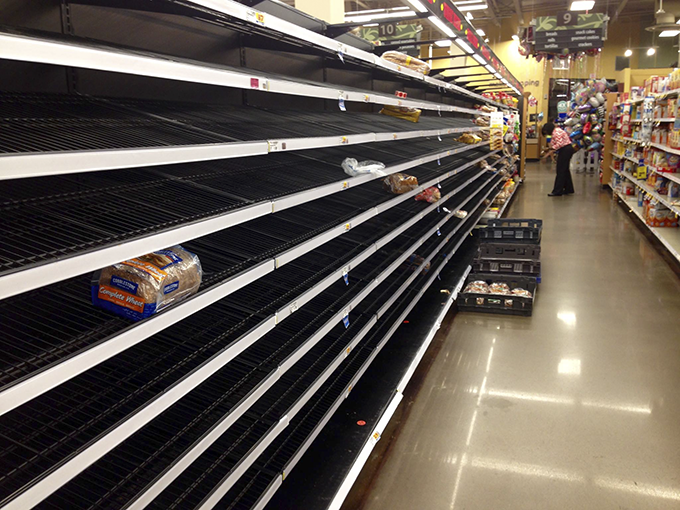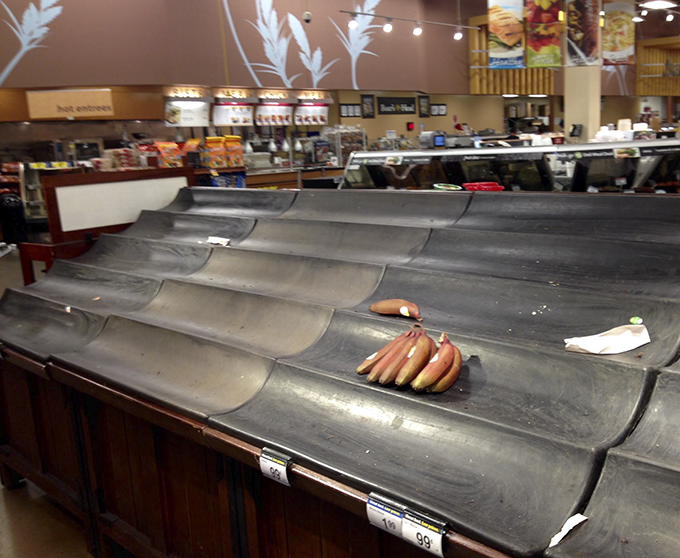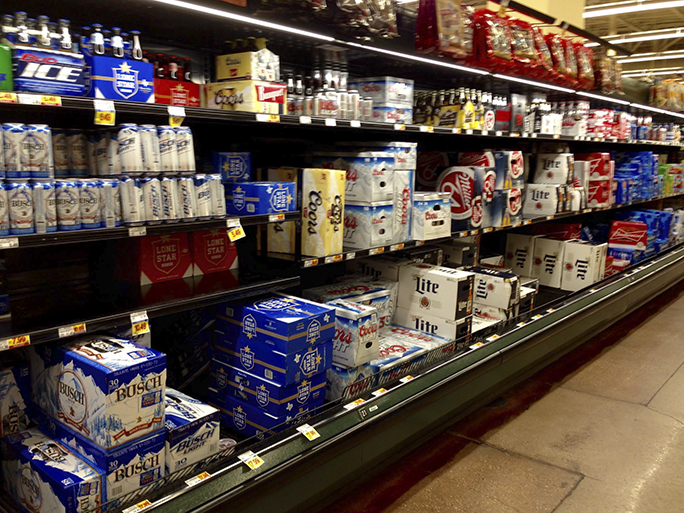
Tropical Storm Bill. So dreary, so droll, so dowdy and aptly named. The Lumbergh of storms: when looming over our shoulders, a feared entity, but revealed in the course of time to be a relative weenie and a drip. That guy up there is windsurfing in Matagorda Bay even as the storm made landfall. Bill, do you even storm, bro?
And yet Lumbergh’s ravages saw to it that some Houstonians got the day off. Classes and camps were canceled. Houston Independent School District robots graciously called me at 5:37 in the morning to tell me that my daughter need not come to summer school, which would have been news I could have used had she been enrolled in summer school. Local news went into Armageddon overdrive, and frantic shoppers picked store shelves clean the night before the deluge.
All that for what in Greater Houston amounted to a nearly windless day of a few, gentle showers that wouldn’t have been sufficient to cancel a high school football game a couple of decades ago.
This is not to diminish the rains some of the coastal areas weathered during this “well behaved” tropical depression (or the ones still to fall in North Texas, especially near already bulging Lake Texoma), but Houston’s reaction to this storm should call to mind the lessons we learned during Hurricane Rita, when, ten years ago this September, three million of our residents fled into the teeth of one of America’s worst traffic jams to escape a storm that did not even threaten their homes.
More than half of these people had no business being on the roads. Most were fleeing the phantoms of Katrina rather than the prospect of Rita, and maybe it’s because this TS Bill rain “event” has come so hard on the heels of the Memorial Day floods, or maybe it’s because this town has filled with so many newcomers since Hurricane Ike brought us our last dose of tropical medicine, that there was so much ado in Houston’s grocery stores Monday night over so little substance.
As usual, local media did little to tamp down fears. Hell, Houston’s CBS affiliate even trotted hurricane ghoul Dr. Neil Frank out of retirement. We knew it had to be serious then. Frank came to KHOU in the eighties, straight from more than ten years as director of the National Hurricane Center in Coral Gables, Florida, where during his final years, he’d become something of a national pundit. Back then he was known for his increasingly chilling, doom-laden prognostications, and in 1985, after Frank claimed on Nightline that Hurricane Gloria was “the storm of the century,” and that “all 24 million residents of the Eastern Seaboard [were] staring down the barrel of a gun,” Hunter S. Thompson branded the forecaster a “hopeless hurricane junky” who “drove millions of people crazy with fear and confusion.”
Just the right guy to be a chief meteorologist at a Houston TV station, which is exactly what he became shortly after his retirement from the NHC in 1986. And he would be denied another hurricane fix for the rest of his working career: Frank missed Alicia by four years and retired a few short weeks before Ike got to town. In between, there was Rita, his one big chance at a storm, and some Houstonians believe that Frank was something less than entirely relieved when that awful storm spared his broadcast area its worst ravages.
How many times did you hear an anchor say, “Prepare for the worst, hope for the best?”
“Hunker down” and “dodged a bullet” were very big, too. I wondered, did somebody type those cliches into the teleprompter, or were they ad libbed cliches?
TV weathermen — two in particular — looked like they needed to be sent to Vienna for clinical depression when Rita sidestepped Houston.
For Channel 13’s Tim Heller, this would have been his first Big Story, the chance to make a name for himself in Houston. For Channel 11’s Dr. Neil Frank, this could have been his last rodeo.
Funny, when he was director of the National Hurricane Center from 1974 to 1987, Frank advised local TV weather forecasters against making their own predictions when hurricanes threatened. Just stick with what the National Hurricane Center gives you, he said.
Now that he’s a local guy, Frank was among the last to cry uncle and admit the hurricane would likely miss us.
Hyping weather events is not unknown in other cities, of course, but it’s unlikely that any other place has suffered a tragedy as serious as Houston’s Rita evacuation, when incorrect and/or possibly overblown weather forecasting led to more Texans dying than during Allison, Ike, Alicia, and Carla combined: 107 died in accidents, in fires, or of exposure, trapped under a broiling sun at the side of an interstate in one of the largest traffic jams in American history.

Those in flood-prone coastal areas were wise to flee. It was all those who got in their way—people from places like Sugar Land, West University, and Tomball—who created the problems. Of the estimated 3 million who fled, only 1.2 million or so had been advised to. And as Mayor Bill White pointed out at the time, families were taking all of their cars, fearing that their houses would blow down and their cars would be submerged.
North and west of areas like Clear Lake, this made little logical sense, but logic had drowned a couple of weeks earlier. The entire city was then in the grip of Katrina Terror: a fear that our city would be plunged beneath brown waters, that law and order would wash away, that looters would pillage the corner Fiesta Marts and Spec’s, hauling away their ill-gotten swag. That once the mighty Rita came through, the winds were gonna bring down trees, the rains would flood the town and bust the levees, and then…
Well, nobody seemed to snap to the fact that Houston had no levees, nor does our city sit in a basin at or below sea level.
And so hundreds of thousands of people fled who had no need to flee, even if Rita had hit Houston head-on. There were the 23 senior citizens who burned to death on a faulty chartered bus while being shuttled from their facility in Bellaire, where it barely even rained, to Dallas. A 51-year-old man and two of his children lost their lives when their car overturned en route from Dallas to their hometown of Sugar Land, a suburb well beyond the threat of storm surge. A Houston toddler was killed along the side of Highway 59 near Lufkin when another Houstonian fell asleep at the wheel after twenty hours on the road and ran her over. These were tragedies, made all the worse by the fact that none of these people should have been where they were when they died.
Fast forward to present day. Yes, I’ll grant that after the Memorial Day floods of 2015, caution had reason to be high. And knowing the way Houston operates, it wasn’t entirely shocking to see the following scene at the Kroger in the Houston Heights, near the corner of West Eleventh Street and North Shepherd Drive, around nine-thirty Monday night:

But given the information we did have—the city was in the path of a tropical storm with maximum sustained winds of about 45 mph—did it make sense that all of the drinking water should be gone? Shouldn’t we have been armed with the knowledge that a storm like Bill likely wouldn’t incapacitate the municipal water supplies? That supermarkets and drugstores wouldn’t shut down for days on end? Honestly, when was the last time we heard about a tropical storm hitting a city and hordes of unprepared people perishing wretchedly of thirst? Better get down to the store and stock up on enough water to quench the thirst of a company of French Legionnaires marching through the Sahara, just in case. (Kroger was still open the next evening, nearly empty of people, its precious water supply replenished.)

There was also a run on bread, presumably for PB&J’s. Because that’s a sandwich made of relatively nonperishable spreads, and Houstonians would be needing large supplies of those for the long refrigeration-less nightmare to come along with life post-Bill.

The same goes for bananas. No chilling needed for these bad boys (plus, they can go in the PB&J’s for an Elvis Special). Now, here are a couple I can’t explain, other than to say that the Houston Heights, once a hard-drinking and rootin’ tootin’ neighborhood, despite the fact that much of it is officially dry, has gone uptown and big-time.
Here we see that on the last night before the deluge, the Kroger was almost out of sushi…

…and yet well-stocked with beer.

A Houston that values California rolls over Lone Star on the eve of tropical storms is not the Houston I grew up in, nor even the Houston of Ike, seven years ago.
Seeing this also forces us to consider how the rise of social media affects storm prep. People report snatches of things they heard on the news and more people repost them pell-mell via Twitter and Facebook, such as a report I heard out of context that one Houston weatherman—the levelheaded Frank Billingsley, the first to accurately report Rita’s jog to the east of Houston—had speculated that Bill might dump as much as two feet of rain on Houston. He did say that, but only threw it out there as a doomsday scenario to be dispelled by a guest expert he had in studio for the occasion. But when you hear only that “Billingsley says we might get two feet from this thing!,” even storm veterans would be excused for freaking out a bit.
The farther our information gets from the sources, the more it is warped and diluted. In the panic leading up to this storm, while some new residents were attempting to acquire sandbags to save their home from flooding (though it did not flood on Memorial Day), others were spotted literally weeping for the salvation of our city in supermarkets, schools were closing down, and half the population was out hoarding precious life-giving foodstuffs, the director of Galveston’s NOAA lab sent this memo to his staff:
The Galveston Laboratory will be open on Tuesday (June 16). At 8 PM CDT the Tropical System off the Texas Coast is moving to the Northwest and all the computer models currently show the system moving on shore near Port O’Connor, TX. Tomorrow morning we may experience some periods of heavy rain as the system moves inland. Please use caution as you drive in these rainy conditions.
For most of the Houston area, that was about all you needed to know about Gentle Bill, the Tropical Storm that didn’t.
(Photographs from AP [windsurfer, Rita traffic jam] and John Nova Lomax [supermarket shots])






